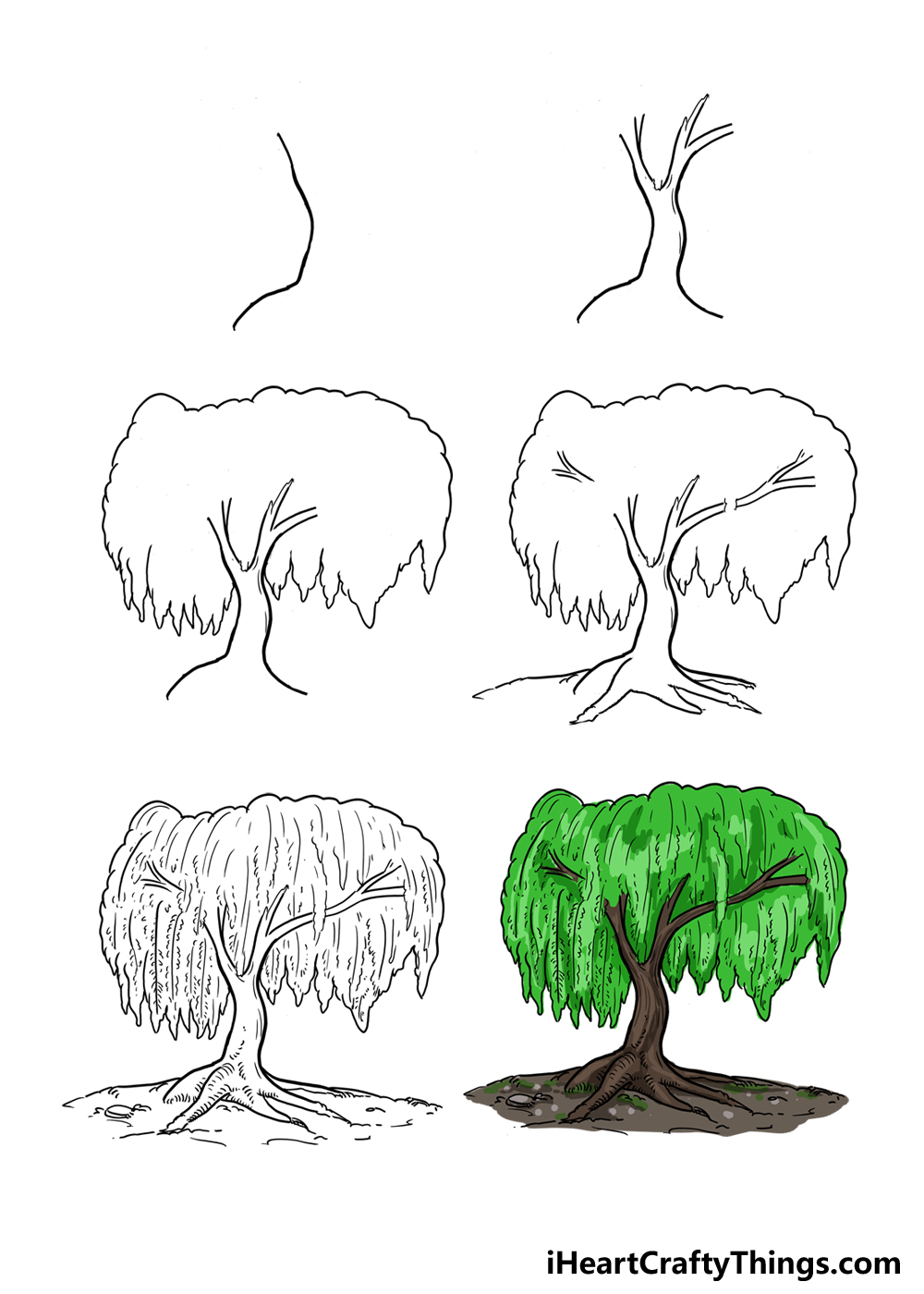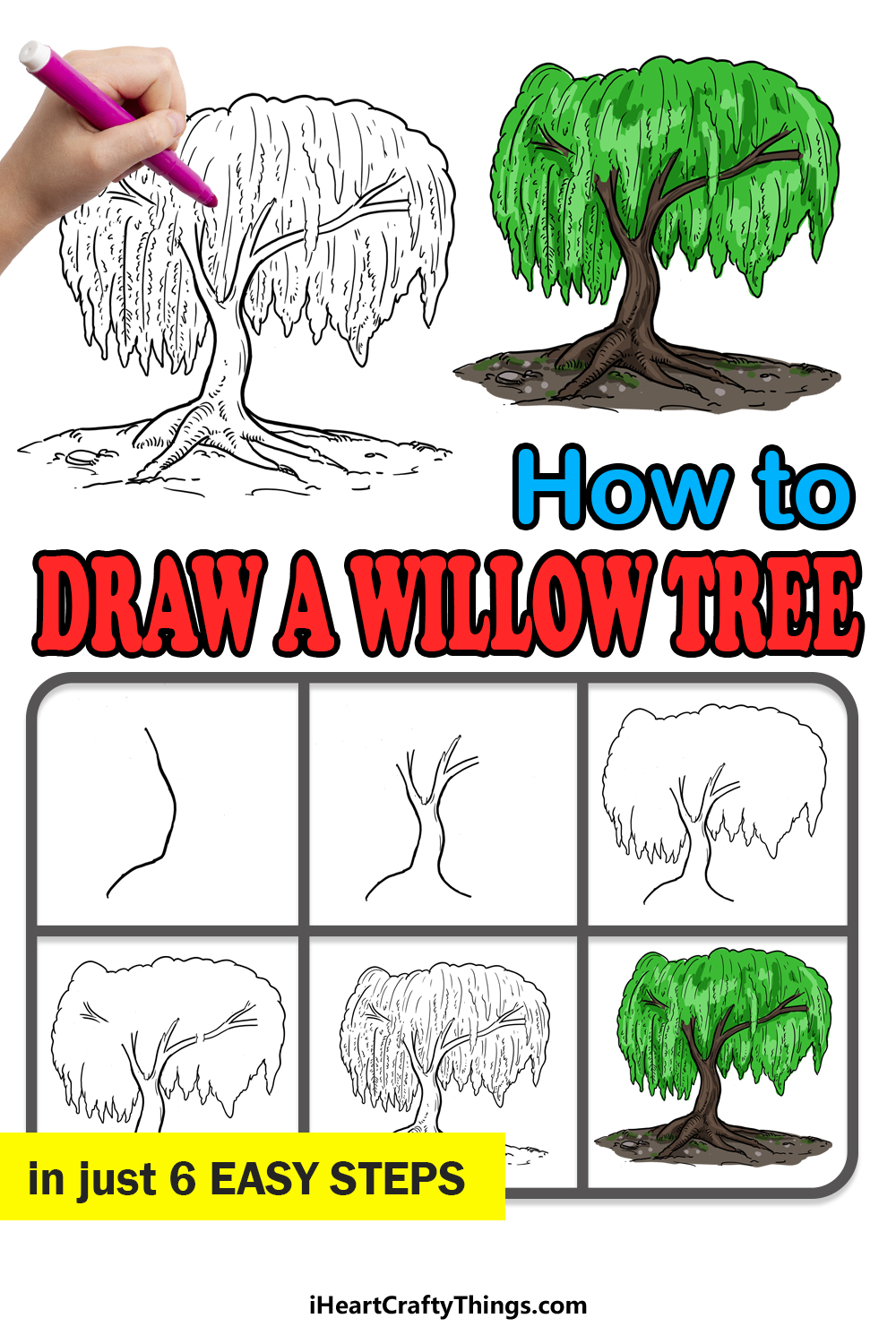In nature, there are thousands and thousands of different kinds of trees. They can not only be fun to look at and improve the scenery, but they can also be useful for many other things.
Among all the different species of trees, the willow tree is a favorite of many. This tree has a really distinctive look and is an amazing addition to any garden, yard or landscape.
It’s no wonder that it also often appears in various artwork and pictures, and this makes it popular for people to learn how to draw a willow tree.
This can be tricky, as the very thing that makes a willow tree so great, its distinctive look, can make it equally tough to draw.
That’s why you’re in the right place if you would like to see how it can be done!
In this guide, we will be taking you through six steps that will show you how fun and easy it can be when you know what to do. We will also go over a few ways that you can add your own ideas and changes to the design.
So let’s begin and see how it’s done!

How to Draw A Willow Tree – Let’s Get Started!
Step 1

When it comes to drawing a willow tree, there are two main components. These would comprise the trunk and the leafy canopy, and we will start with the first of these.
The leafy canopy of a willow tree is probably its most recognizable feature, and it will thus be a big feature of this drawing. That being said, it’s still important to portray the trunk and branches properly.
The trunk and branches are more complex than they appear, as they are a bit twisty and intricate.
For now, we will make it easier by simplifying the steps of drawing this trunk and its attached branches.
To do this, we will be drawing just one line to begin the outline. Before you draw this outline, you can use a pencil to draw a rough version of the willow tree.
This can seem like an unnecessary step, but it will help you to maintain the correct proportions for the drawing. It will also help you to visualize the trunk, leaves and how they all relate to one another.
With that in mind, we can draw the first line. We will be drawing the line on the left-hand side of the trunk, as shown in our reference image.
It will be a rather sharply curved line that bends inward. You should also avoid making the line too smooth, as we want to make it look like it has a bark texture.
Then, we will be ready to move on to step 2!
Step 2: Draw the next part of the tree trunk

In the first step of the guide, we drew the first part of the trunk for this willow tree drawing. That first line was simple, but this is where it starts to get trickier.
The trunk of a willow tree is pretty distinctive in and of itself, and it has a thin body with some twisty branches.
It’s got a rather mangled look beneath the leaves, and we will try to replicate this in the drawing.
First, we will draw the line on the right-hand side of the trunk. As you will see in the reference image, this should somewhat mirror the line on the left side that you previously drew.
You will also see that there should be a large base for the trunk, as we will add some roots there later. For now, the line on the right should head up and then curve out to the right.
Then, we will add two diagonal lines to the left of this that form a V shape. To finish off this step, we will use some more curved lines to create a larger V shape at the center of the top of the trunk.
There will be some small lines poking off i various places, and these will come into play later on in the guide.
For now, we will be ready for the third step of the guide, so let’s head there when you’re ready.
Step 3: Add the outline of the leafy canopy

We will come back to the trunk later on in the guide, but for now, we will leave it and focus on the leafy canopy.
For this step of your willow tree drawing, we will focus on drawing the outline of the canopy.
This canopy will begin and end around the center point of the trunk, and the base of this outline will look quite a bit different from the top.
You will see that the top of the canopy is somewhat flatter, but it will still be drawn with a bumpy line.
The lower portion of the canopy, on the other hand, will have lots of small, thin sections hanging down. These will still be drawn with a similarly bumpy line to the top of the canopy.
Drawing these portions like this will create the look of the leaves hanging down like they would on a real willow tree. The sides of the willow tree canopy should extend quite far outward.
A willow tree looks a bit like an umbrella with the top fanning out, and we will show this in our reference image. It may look a bit weird as it is now, but we will still be adding some more branches as we head forward.
For now, if your drawing is matching the reference image, then you’re in a good spot! Next, let’s head to the next step and add some more details that will make this willow tree look even better.
Step 4: Now draw some more branches and roots

This tree is really starting to take shape! In this fourth step of our guide on how to draw a willow tree, we will make it look even better with some additional branches and roots.
These are small parts of the design, but they make a big difference when it comes to making this look like a real willow tree. First, let’s focus on the roots of the willow tree.
The roots will look a bit like fingers extending from the base of the tree. These will be drawn with some long, slightly curvy lines that each end in a rounded tip to show the roots snaking out.
We will also add a horizontal horizon line to the background, as shown in our reference image. Before we move on, we also need to add some branches poking out.
These branches will be different to the previous ones, as they will not be visibly connected to the trunk. Instead, they will poke out from the leafy canopy of the willow tree.
Other than that, they can be drawn rather similarly, and they will be drawn with the same curved lines.
The branches we’re drawing on the right-hand side of the canopy will look like they’re connected to the branches we drew previously.
There will be a small gap between them, though. The branches poking out on the left will be poking seemingly out of nowhere, though.
Now, we are ready for some final touches in the next step of the guide.
Step 5: Draw the final details and any extra touches for this willow tree

As you will see in the reference image, we will be adding a ton of details in this step. This will prepare you for the final step where you will add some color to your artwork.
The intricate level of details that we will be drawing in this step may seem intimidating, but it’s not as difficult as it may seem. First, let’s start with some of the simpler details.
These will go on the trunk and will be composed of some small, curved lines to give it some texture. Then, we will add some small rock and grass details on the area around the base of the willow tree.
The details inside the outline of the canopy of the tree will be a bit more complicated, but it’s not as bad as it looks. You can start by drawing a series of slightly curved vertical lines.
Then, add some smaller little curved lines around these larger lines. If it sounds complicated, you’ll see what we mean in the reference image.
Once you have added these details, you will be ready for the final step of the guide! You don’t have to move on just yet, however. You can also add some of your own ideas.
For example, you could show the background behind the tree, or maybe someone could be sitting underneath it.
If you were to do the second idea, you could make the person look like someone you know.
They could even be based on yourself! These are just a few ideas, but there are many more you could go for.
It’s up to you now, so what are some ways that you can put your own spin on this drawing?
Step 6: Now, finish off with some color for the willow tree

Nothing brings a picture to life like adding some color, and that is just what we will do in this final step of the guide.
You will see in the reference image that the two main colors we went for are brown and green.
Even though these are the main colors, there are many variations of each on.
For the green leaves, we mixed in lots of different shades to give the leaves some depth and variety.
The same is true for the wood and dirt surrounding the willow tree. When you color your own one, you can also try to use different tones to make it look more dynamic.
You could also change the colors entirely to make the tree look older or to make it look like there is a certain season in the background.
When coloring your picture, choosing the colors is just a part of the process.
You can also have some fun picking the art tools and mediums that you use to color in your picture. You could use some paints such as watercolors for a softer look to the colors, for instance.
Colored pens or heavier paint like acrylic paints can be used to make the colors darker. You could always have a mix of both approaches as well.
This can be done to make the colors even more interesting and dynamic. There are so many different options, so which ones will you choose to finish off your own version?
Your Willow Tree Drawing is Complete!
The willow tree is one of the most unique trees in nature, and now you know what it takes to draw one!
In this guide on how to draw a willow tree, we wanted to show you just how fun and easy it can be.
We hope that the steps in this guide made it easy for you to complete, and that you have some inspiration for how you can make it even more unique and fun.
There are so many possibilities, so now it’s up to you to see what you can do. Don’t be afraid to get creative with it and try out some interesting new combinations of colors and details.
When your willow tree drawing is complete, we would definitely love to see how it looks! When it’s done, you can share your creation on our Facebook and Pinterest.
This is the best way for us to see how it turned out, and we will be able to see what an awesome job you did.



